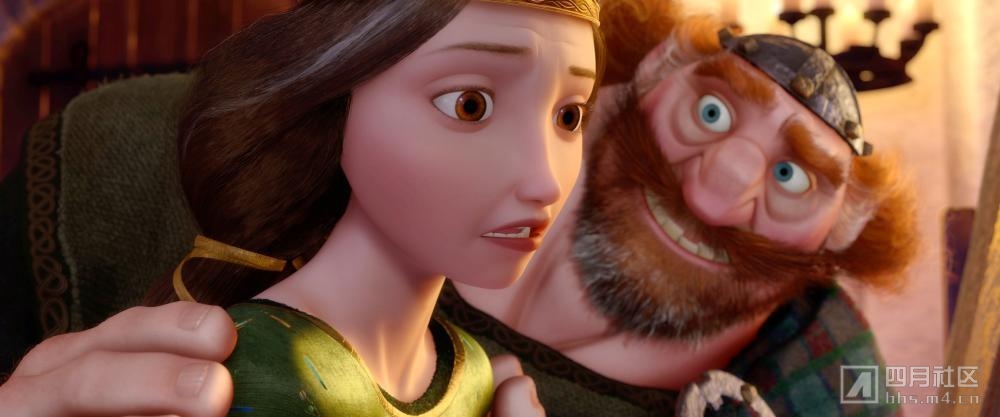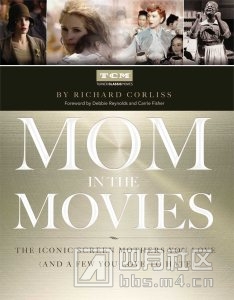|
|
【中文标题】妈妈杀手——迪斯尼
【原文标题】Mom in the Movies: How Disney Killed Off Mothers, and Pixar Liberated Them
【登载媒体】时代周刊
【原文作者】Richard Corliss
【原文链接】http://time.com/#53766/movie-moms-pixar-disney/
在经典动画片中,比如《小飞象》和《小鹿斑比》,母亲是一个岌岌可危的物种(即使在《冰雪奇缘》中也是如此)。直到半个世纪之后,皮克斯才让人们看到妈妈也可以是强壮(《超人特工队》)、须发浓密的(《勇敢传说》)。

究竟有多少位妈妈在和家人一起观看迪斯尼动画片之后,无奈地给泪汪汪的孩子解释剧中人物的死因?自从这家公司在1937年首映第一部动画片《白雪公主和七个小矮人》之后,保守的估计也有上千万吧。无辜的父母或许以为,一部音乐卡通神话剧应该是让孩子接触电影艺术的理想方式。但是沃尔特•迪斯尼却用更有效的方式给孩子上了一堂道德课程——把小家伙们吓出屎来。
当孩子们看到白雪公主被她的继母巫婆用苹果毒倒,他们在电影院的座椅上留下了人生第一个由原始恐惧带来的污迹。迪斯尼的影片,尤其是早期影片,都是由一些可爱的小动物演绎的恐怖电影,以及优美旋律下的希腊悲剧。这些影片迫使孩子面对失去家园、父母、朋友和心爱的宠物,等于是给4岁的孩子实施休克疗法。这种心理阴影可能会延续一生,或许至少等到蹒跚学步的孩子长大成人,让他们自己的孩子也经受和他们一样的恐怖经历。
第一代迪斯尼经典影片给童年增添了一系列无情的噩梦。背景暗示了一个类似于《哈姆雷特》第五幕那种宫廷谋杀情节,白雪公主(Adriana Casselotti配音)变成了孤儿,死去的国王和王后被继母(Lucille La Verne配音)取代,她强迫王妃在厨房里做杂役。新女王既虚荣又邪恶,当她的魔镜告诉她已经不再是“世界上最美丽的人”,她命令一个猎人去杀害白雪公主。女孩只好从家中逃出,与7个善良的陌生人生活在一起。她负责做饭、打扫和创造快乐的气氛,实质上,她变成了这些小矮人的妈妈。
对年轻的消费者来说,迪斯尼经典卡通影片传达出比较复杂的信息。白雪公主必须离开自己的家才能保住性命,但是当《木偶奇遇记》的主角离开他的创造者、类似于父亲的杰佩托之后,一个名叫斯特龙伯利的绑匪对这个木头小人说:“你长大之后会是一块好劈柴。”在《白雪公主》里,猎人拯救了女主角,但是《小鹿斑比》的情节——或许是所有迪斯尼动画片中最残忍的一幕——另一个猎人用枪杀害了小鹿的妈妈。一个生物的母亲成为了另外一个人的午餐。
实际上,在所有迪斯尼动画作品的人物中,最濒危的物种是母亲——这个事实足以吓坏那些和自己的妈妈一起坐在黑暗的影院中的孩子们。(握紧她们的手吧,小家伙们,确保她们还活着。)不管是小男孩还是小女孩,都会设想自己是影片中的主角,当然也会认为影片中的妈妈就是自己的妈妈。所以呢?斑比的妈妈死于一场意外的混乱。在《小飞象》中,马戏团大象珍宝夫人是一个单身母亲,他的孩子小丹波因为超大的耳朵被人取笑。在一场演出中,一个男孩恶意地揪丹波的耳朵,珍宝夫人上前保护孩子,结果引发了一场大混乱。她最后被关起来,而她的孩子与一只颇有智慧的老鼠和一只话唠乌鸦一起流浪。
迪斯尼动画片中成年女性的命运大抵如此:母亲都是完美的,但命运多舛;继母邪恶、嗜杀成性;救星温柔体贴、法力无穷。还记得《仙履奇缘》中的贵族鳏夫愚蠢地认为女儿需要母爱,而与傲慢的崔梅恩夫人结婚。在这个可有可无的父亲去世之后,崔梅恩与她的两个笨女儿安泰西亚和崔西里亚把灰姑娘当作一个卑微的仆人。继母的霸道与仙女的魔法形成鲜明的对比。口念“Bibbidi-Bobbidi-Boo”,一只南瓜就变成了一辆皇家马车,女孩的破衣服变成银光闪闪的晚礼服,还有一双捕获王子眼睛和内心的水晶鞋。
仙女,比如《奥兹国历险记》中的女巫,有的仁慈可爱,有的邪恶傲慢。在《睡美人》中,三个善良仙女的祝福未能阻挡黑女巫(由给崔梅恩夫人配音的演员Eleanor Audley配音)对荆棘公主的诅咒。这部1959年的影片是沃尔特在1966年去世之前迪斯尼最有一部动画神化作品。
若干年之后,在Jeffrey Katzenberg领导下的动画“复兴”行动中,公司以《美人鱼》和《美女与野兽》再次回归神化故事领域。这两部动画片的女主角都有父亲,没有母亲。另外两部作品《风中奇缘》和《木兰》的女主角也和她们的母亲扯不上关系,尽管宝嘉康蒂有一个柳树祖母——一棵会说话的树。
近期的迪斯尼动画作品大多改编自格林童话,《公主和青蛙》以及《长发公主》都给片中的女主角配备了全套的父母,Oprah Winfrey给青蛙王子的母亲配音。迪斯尼还把Hans Christian Andersen的《冰雪皇后》改编成现代版本的《冰雪奇缘》,成为2013年全球热门影片。按照迪斯尼的伟大传统,公主的自由解放之路再一次让她的父母在早期付出了生命的代价。
《长发公主》讲述了一个经典的迪斯尼公主的故事——随着年龄的增长,战胜一系列的困难,最终长大成人,其中还包括了一个颇为现代的旋律:利用各种方法寻求青春永驻。当然还有不可缺少的迪斯尼大反派——邪恶的女巫。葛朵(Donna Murphy配音)发现年轻的长发公主不知为何能给一个干瘪的老太太带来永恒的青春,她偷偷潜进王宫,把受害者锁在一个高塔上,直到她的18岁生日。葛朵就像当今所有的美国父母一样,以为把孩子锁在家里就能让他们永远不进入青春期。当然葛朵是一个继母的角色,长发公主亲生父母品德高尚、担惊受怕,在剧中的戏份极少。
《公主和青蛙》和《长发公主》给历史上的动画片题材提供了稍许平衡的因素,从前的电脑动画片基本上不关注女性角色和她们的子女。梦工厂的影片(《怪物史莱克》和《马达加斯加》系列)基本上算是歌舞杂耍戏。福克斯出品的《冰河世纪》把Bob Hope和Crosby的《去中国之路》带到了史前的冰河时代。环球影视的《神偷奶爸》勉强提到了父母,但也仅仅是从一个认为自己是超级恶棍的单身父亲视角讲故事。
皮克斯利用第一部电脑3D动画作品《玩具总动员》取代了迪斯尼手工绘画的传统,它没有继续使用男孩女孩、母亲孩子的方式来推动故事情节,而是主要讲述朋友之间的哥们义气,比如《玩具总动员》、《汽车总动员》、《怪物公司》、《虫虫危机》、《料理鼠王》、《机器人总动员》和《飞屋环游记》。到目前为止,皮克斯只有两部作品中出现了重要的母亲角色。在《超人总动员》中,超级英雄Helen(Holly Hunter配音)要管好三个具备超能力的孩子,与丈夫超人先生合作来拯救世界。
2012年皮克斯终于拿出了一部完整讲述母女故事的作品。《勇敢传说》(导演之一是Brenda Chapman,这家工作室的第一任女性负责人)走的是经典迪斯尼路线——一名具备有反叛意识的公主与专横的女王对抗,并且被施加了魔法,这部影片颇有耐人寻味之处。这一次,让主角历尽苦难的不是继母,而是她的亲生母亲。
在古代的苏格兰,小女孩梅丽达(Kelly Macdonald配音)的性格就像她一头卷曲的红发一样狂野。她擅长射箭,就像《饥饿游戏》中的Katniss。梅丽达感觉与她那捕狮猎熊的父亲——国王弗格斯(Billy Connolly配音)——的男子气概更亲近,而与她母亲埃莉诺(Emma Thompson配音)温文尔雅的性格不合。她既是个假小子,也是个郁郁寡欢的少女,每天只会用两个字“Mah-ahm”回应母亲的唠叨。当她被要求在求爱者中选择自己的丈夫时,梅丽达大冲她的亲生母亲大喊“我希望你去死!”王后没有死,但是变成了一只熊——一半是优雅的埃莉诺,一半是巨大、笨拙的生物。

孩子们总是把父母想象成怪兽,当《勇敢传说》变成了《我的母亲大熊》,触发了父母的无助和儿童对受伤动物爱怜的情绪。在这个版本的《美女与野兽》中,富有同情心的野兽竟然是妈妈,这难道不是一个美丽的故事吗?
原文:
In classic animated features like Dumbo and Bambi, mothers were often an endangered species (and in the case of Frozen, still are). It took a half-century before Pixar showed moms who could be strong (The Incredibles) and, well, hairy (Brave)How many mothers have emerged from a family trip to a Disney movie and been obliged to explain the facts of death to their sobbing young? A conservative estimate: the tens of millions, since the studio’s first animated feature, Snow White and the Seven Dwarfs premiered in 1937. Innocent parents might have thought that a musical cartoon version of a fairy tale would be a child’s ideal introduction to movie magic. Yet Walt Disney taught moral lessons in the most useful way: by scaring the poop out of the little ones.
As kids watched Snow White succumb to the poison apple proffered by the witch who was also her stepmother, they literally stained the seats of movie palaces with the first rush of primal anguish. Disney features, especially the early ones, were horror movies with cute critters, Greek tragedies with a hummable chorus. Forcing children to confront the loss of home, parent, friends and fondest pets, these films imposed shock therapy on four-year-olds. That psychic jolt could last a lifetime — or at least until the toddlers grew up and subjected their own children to the very same animated ordeals that they had undergone at the same age.
Those first Disney classics defined childhood as an unrelenting series of nightmares. In a backstory that suggests a palace murder spree as lurid as Hamlet Act Five, Princess Snow White (voiced by Adriana Casselotti) has been orphaned, with the dead King and Queen replaced by a stepmother (Lucille La Verne) who forces the dauphine into scullery-maid servitude. As vain as she is vindictive, the new Queen reacts to her talking mirror’s news that she is no longer “the fairest of them all” by ordering a huntsman to kill Snow White. The girl can survive only by fleeing her home and depending on the kindness of seven small strangers, for whom she cooks, cleans up and enforces cheerful discipline — becoming, in essence, the dwarfs’ doting mother.
To their young consumers, the Disney cartoon masterpieces sent mixed signals. Snow White must leave home to live; but when the puppet hero in Pinocchio (1940) goes AWOL from his creator and father-figure Gepetto, a Faginesque kidnapper named Stromboli tells the wooden boy, “When you grow too old, you will make good firewood.” In Snow White, a huntsman saves the heroine; but midway through Bambi (1942) —perhaps the most shocking moment in any Disney fable — another man with a rifle mistakes the deer’s mother for disposable game. One creature’s mother is another’s lunch.
Indeed, among the most endangered of all Disney denizens were mothers — a fact that should have terrified the kids sitting next to their own moms in a darkened movie house. (Keep holding her hand, little one, to make sure she’s still alive.) A young boy or girl was naturally invested in the adventures of the movies’ young heroes or heroines, and would infer that their mothers were his or her mother. So what happens? Bambi’s mother dies in an act of random violence. In Dumbo (1941), the circus elephant Mrs. Jumbo is the loving single mom of her baby Jumbo Jr., who has been derisively nicknamed because of his outsize ears. When a boy at one performance cruelly pulls on Dumbo’s ears, Mrs. J. stomps forward to protect him and inadvertently causes a stampede. She is consigned to a madhouse, and her child to a life of pachyderm vagabondage in the company of a helpful mouse and some jive-talking crows.
The Disney animators’ rules on adult females: mothers are perfect but imperiled; stepmothers are wicked and occasionally homicidal; godmothers are sweet things with magical powers. Recall that the aristocratic widower father in Cinderella (1950) unwisely thought the girl needed maternal guidance and married the haughty Lady Tremaine. When the disposable dad dies, Tremaine and her gawky daughters Anastasia and Drizella treat Cinderella like a despised menial. The stepmother’s dictatorship finds its liberating equal in the Fairy Godmother’s magic. Say “Bibbidi-Bobbidi-Boo,” and a pumpkin is transformed into a royal coach and the girl’s rags into a silver blue dress, with glass slippers to catch a Prince’s eye and heart.
Fairy godmothers, like the Witches of Oz, can be benign or malign. In Sleeping Beauty (1959), the blessings of three kindly fairies can barely hold off the curse of the evil Maleficent (voiced by the same actress, Eleanor Audley, who had played Lady Tremaine) on the princess Briar Rose. That 1959 film was the last animated fairy tale produced by Disney before Walt’s death in 1966.
A generation later, in the animation “Renaissance” under Jeffrey Katzenberg, the studio would return to fable territory with The Little Mermaid (1989) and Beauty and the Beast (1991), both of whose heroines had fathers but no mothers. The female protagonists of two other Disney Renaissance features, the 1995 Pocahontas and the 1998 Mulan, also have to do without mothers, though Pocahontas does have a Grandmother Willow — a talking tree that croaks advice and warnings.
More recent Disney animated features based on Grimm stories, The Princess and the Frog (2009) and the “Rapunzel” adaptation known as Tangled (2010), outfitted their leading ladies with a full complement of parents; Oprah Winfrey voiced the role of the frog-princess’s mom. Disney also modernized Hans Christian Andersen’s story “The Snow Queen” into the worldwide 2013 hit Frozen, a story of princess liberation that, in the grand Disney tradition, killed off both parents early on.
Tangled weaves the tale of a classic Disney princess — whose destiny is to come of age, triumph over adversity and, in general, woman up — with a very contemporary obsession: looking young by any means necessary. Re-enter that old reliable Disney villainess, the wicked witch. When Gothel (Donna Murphy) discovers that the 70-foot tresses of young Rapunzel (Mandy Moore) somehow bring eternal youth, or at least chic middle age, to an old crone, she swans around the kingdom while keeping her victim locked in a tower from infancy to her 18th birthday. Gothel could be many modern American parents who think that confining their teens in enforced preadolescence may make them feel younger too. Of course Gothel is a stepmother figure; Rapunzel’s real mother and father are virtuous, fretful and mostly absent.
The Princess and the Frog and Tangled restored a smidge of equilibrium to the animated films of the preceding decade, when the major producers of CGI cartoons paid little attention to female characters and their offspring. DreamWorks movies (the Shrek and Madagascar series) are usually vaudeville capers. The Ice Age pictures from Fox/Blue Sky relocate the Road movies of Bob Hope and Bing Crosby into a prehistoric winterland. Universal’s Despicable Me tandem touches on parenthood, but only from the viewpoint of a single dad who would like to believe he’s a supervillain.
Pixar, which stole Disney’s hand-drawn thunder by launching the first CGI animated feature, Toy Story, in 1995, usually ignored the themes of boy-girl and mother-child in favor of stories about bonding buddies: the Toy Story, Cars and Monsters, Inc. franchises, and A Bug’s Life, Ratatouille, WALL•E and Up. Only two Pixar features so far have boasted strong mothers. In The Incredibles (2004), the superheroine Helen, aka Elastigirl (Holly Hunter), is able to raise three precocious kids while teaming with husband Bob, alias Mr. Incredible, to save the world.
And in 2012 Pixar finally devoted an entire feature to the mother-daughter perplex. Brave (codirected by Brenda Chapman, the studio’s first female director) took the classic Disney formula — a rebellious princess battles an imperious queen and is beset by magic spells — and gave it a beguiling twist. This time, the woman who makes the heroine’s life miserable is not her stepmother but her own mom.
In ancient Scotland, Merida (Kelly Macdonald) is a lass as wild as her curly red mane. An expert in archery, like The Hunger Games’ Katniss, Merida feels closer to the bear-hunting machismo of her father, King Fergus (Billy Connolly), than to the civilizing demands of her mother Elinor (Emma Thompson). She’s both a tomboy and a sullen teen who responds to her mother’s every request by whining, in two harsh syllables, “Mah-ahm!” When urged to choose a suitable beau for a husband, Merida screams, “I hope you die!” at the woman who gave her life. The Queen doesn’t die, but she is transformed into a bear — part regal Elinor, part huge, clumsy creature.
Kids have often thought of their parents as monsters, and when Brave turns into My Mother the Bear, it taps both maternal helplessness and the love a child feels for any wounded creature. In this Beauty and the Beast, the sympathetic beast is a mom. Now isn’t that beautiful?
|
评分
-
1
查看全部评分
-
|
